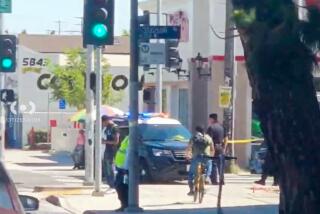Man Killed After Injuring Mubarak : Egypt: Assailant runs up to president’s limousine in Port Said, wounding him in the arm with a knife.
- Share via
CAIRO — A man armed with a knife slashed at Egyptian President Hosni Mubarak and lightly grazed his arm Monday before being shot to death by presidential bodyguards in the Suez Canal city of Port Said, the government said.
The 71-year-old Mubarak, who faces a plebiscite later this month in which he is expected to be granted a fourth six-year term, had been in his limousine waving to well-wishers when the attack came shortly after noon.
The assailant darted through a police line and ran up to the open window of the president’s limousine, the state news agency said. In addition to Mubarak, one of the bodyguards was cut in the hand.
“The special security guards dealt with the incident immediately” and killed the attacker, said a statement by the president’s office. Police later identified the assailant as Said Suleiman, 40, who sold clothing in a Port Said bazaar. Police said Suleiman, nicknamed “the Arab,” had a reputation for being “rash and reckless.”
Officials denied that Suleiman had any political affiliation or motive for the attack, portraying him as a common criminal. But neighbors quoted by Associated Press said Suleiman was believed to be a follower of radical Islamic groups.
The attack came a day after Mubarak had helped broker the latest Israeli-Palestinian interim peace accord, signed early Sunday in the Egyptian Red Sea resort of Sharm el Sheik.
Extremists from organizations such as the Islamic Jihad and the Islamic Group have been engaged in a life-or-death struggle with Mubarak’s security forces for most of the past decade. Their leaders portray the Egyptian president as a U.S. puppet for his pro-Western stance and his support of the Mideast peace process.
But after thousands of arrests and scores of executions, the government appeared to be winning the struggle against the extremists. The number of terrorist incidents is down sharply since early 1998. Some Islamic extremists now are disavowing violence and asking for dialogue instead.
Mubarak was present when Islamic extremists gunned down his predecessor, Anwar Sadat, at a military parade in 1981. Extremists also were implicated in the 1995 ambush of Mubarak’s motorcade in Addis Ababa, Ethiopia--the most serious attack against the president. Mubarak only narrowly escaped a fierce gun battle that time.
After Monday’s attack, state television unexpectedly broadcast the president’s routine speech on economic matters in Port Said--a city of nearly 500,000 at the northern end of the Suez Canal, about 100 miles northeast of Cairo--apparently to reassure Egyptians that he was unscathed.
Mubarak had changed his suit and been treated with an antiseptic. But he showed no outward sign of injury or concern and made no reference to the attack.
Mubarak always is heavily guarded. An attack by a single individual with only a blade did not seem to be a seriously conceived assassination attempt.
Nevertheless, it was an unsettling reminder for Egyptians of the vulnerability of their leader, who despite 18 years in power has never groomed a successor to lead the 65 million people of the Arab world’s most populous country.
For most of his people, Mubarak--a military man whose speech retains a common touch--is a familiar, noncontroversial father figure steering Egypt on an acceptable middle course in international and domestic affairs.
He has liberalized the state-dominated economy and allowed some political and press freedom.
None of the legal opposition parties in parliament bothered to oppose Mubarak’s renomination as president in the Sept. 26 plebiscite.
More to Read
Sign up for Essential California
The most important California stories and recommendations in your inbox every morning.
You may occasionally receive promotional content from the Los Angeles Times.













